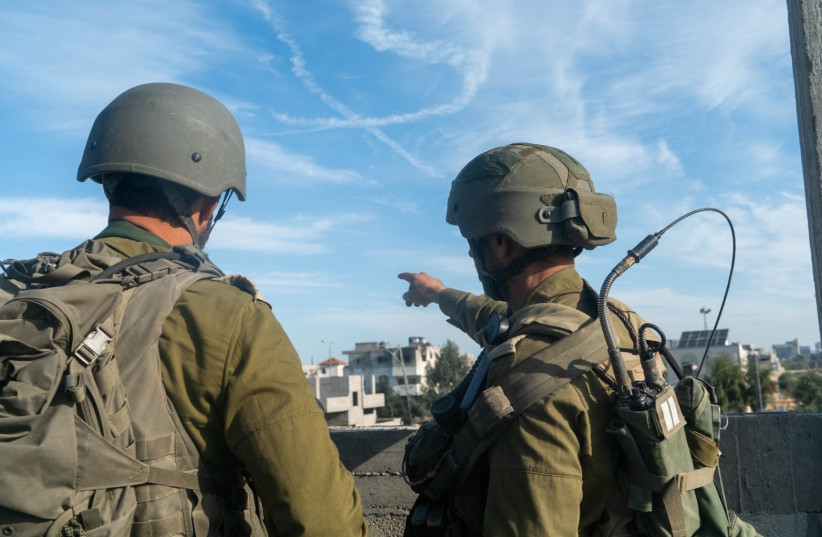Hezbollah and the IDF continued to pound each other on Monday as the West tried, so far unsuccessfully, to engage Israel on security aspects of a ceasefire.
After killing four IDF soldiers and wounding over 60 in a drone attack on the Golani Brigade’s training base near Binyamina late Sunday night, Hezbollah sent round after round of rockets across Israel, from the northern border to Haifa, to central Israel, and Tel Aviv.
The round sent in the evening to the center included three ballistic missiles and sent millions of Israelis into their bomb shelters and safe rooms, triggering alerts for around 180 separate areas.
Reports indicated a small number of injuries and hits, including a direct hit on a structure in Karmiel. The barrage included dozens of rockets and resulted in scenes of people jumping out of their cars to hit the deck by the roadside of the large highways.
Around midday, Hezbollah fired ten rockets at the Haifa area. The IDF said most were intercepted, though some fell in open areas, and later in the morning, rockets were fired at the Netanya area. In this second round of rockets, the IDF said it intercepted all the rockets.
The third round included the direct hit in Karmiel, and a fourth included the ballistic missiles, which sent most of the country’s center into temporary lockdown.
During that attack, air traffic at Ben-Gurion Airport was reportedly temporarily impacted.
The IDF revealed on Monday that 221 out of 1,200 drones sent by Hezbollah landed in Israel in some fashion, though a much smaller, undefined number have struck populated areas or killed or wounded Israelis.
Of the 1,200 drones, the IDF shot down 80%, though other unofficial estimates that factor in different categories of drones place the success estimate closer to 70%.
The IDF said that Israel has been targeted by around 23,000 rockets on different fronts during the current war.
These revelations come after the IDF failed to shoot down the drone on Sunday night, which struck the Golani base.
According to the IDF, the air defense systems tracked the drone in question and fired on it twice, thinking that it was shot down in the Mediterranean Sea.
They were also simultaneously tracking two other drones, which were both shot down, but all of this seemed like a sideshow to a huge barrage of rockets that Hezbollah fired around the same time into northern Israel.
Eventually, the air defense systems lost track of the drone, and it flew over Israel, near highways, for a full 30 minutes to reach its pre-GPS-programmed target of the Golani base in the Binyamina area.
Although the IDF has been working on a solution to the drone problem for several months, it still has had limited success.
The military said it would push its radar and warning systems toward lowering the bar for sounding an alert, even at the price of more false alarms.
Further, recognizing that neither this nor other new efforts to defend against drones may be sufficient, the IDF said it would increase its efforts to target and kill the commander of Hezbollah’s drone unit, Unit 127.
However, the IDF has already killed a large number of such commanders, and drones can be sent out and operated by fairly low-ranked fighters whose identities would often not be known.
On a more successful end of the conflict with Lebanon, the Air Force struck around 200 targets over the last 24 hours, including rocket launchers, anti-tank missiles, and other Hezbollah positions.
Moreover, it took the rare move of striking a primarily Christian town in northern Lebanon, killing at least 18 people, according to the Lebanese Red Cross.
The attack reportedly struck a residence in Aitou, although the IDF has normally gone to pains to avoid hitting any of
Lebanon’s non-Shiite populations to keep the pressure exclusively on Hezbollah and maintain more global legitimacy.
Though Hezbollah is located mostly in southern Lebanon, Beirut, and parts of the Bekaa Valley, the IDF has started targeting Hezbollah figures hiding in more unusual areas.
Still, the IDF did not formally comment on the strike.
Next, the military announced it had assassinated Mohammad Kamel Naim, Hezbollah’s anti-tank missile chief, from its Radwan special force in southern Lebanon’s Nabatieh.
Also, the IDF said that it had located and taken over Radwan’s underground tunnel headquarters, which stretched for hundreds of meters.
According to Syrian reports, two Israeli tanks crossed into Syria on Monday, and positioned themselves near the border town of Kwdana/Kodna, south of Quneitra, which has been the site of several tank battles, most famously in the 1973 Yom Kippur War. The IDF did not comment on the reports.
The IDF has admitted to an increase in air strikes on the Syrian-Lebanese border to cut off any attempts to reinforce or rearm Hezbollah.

